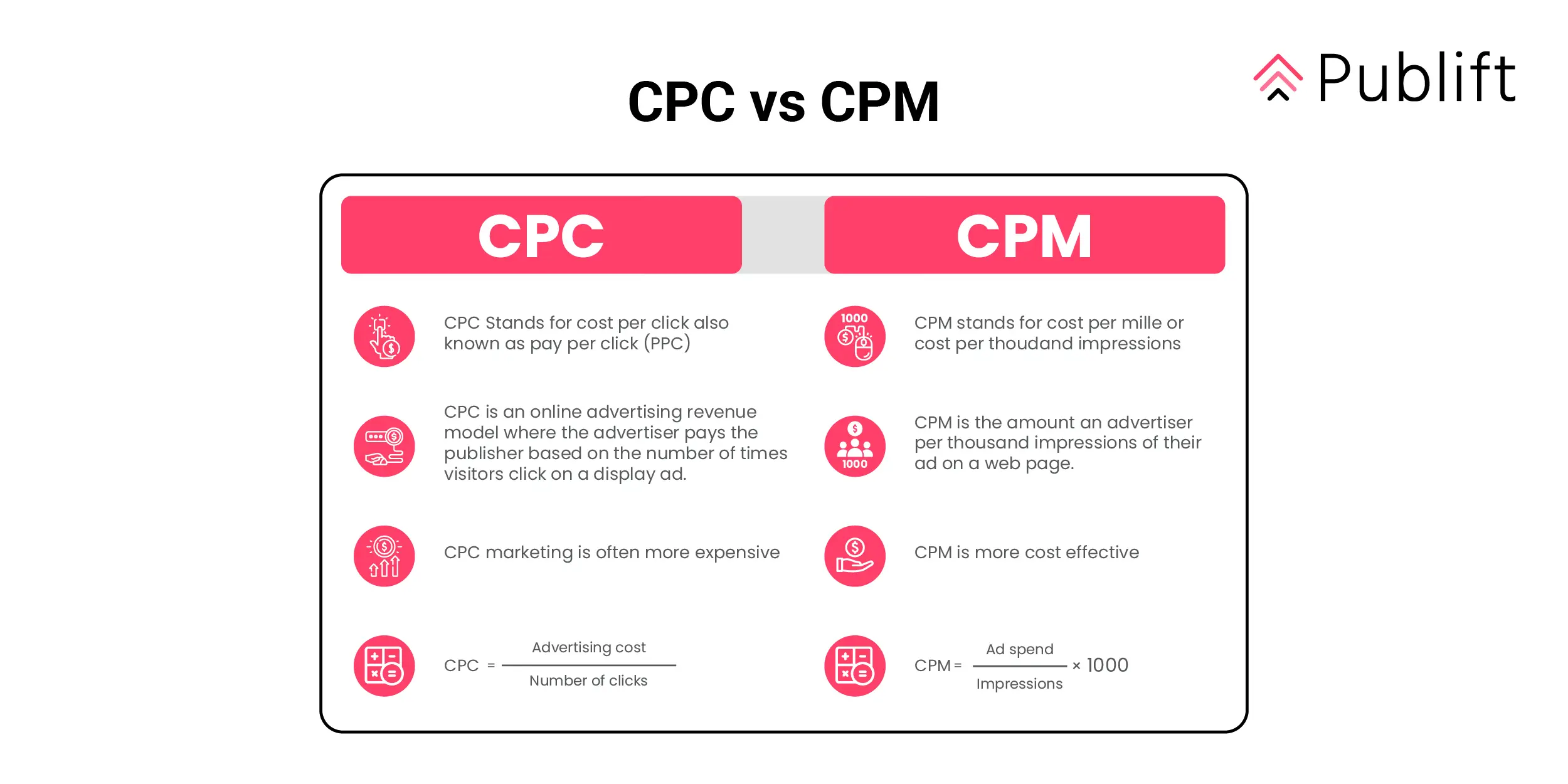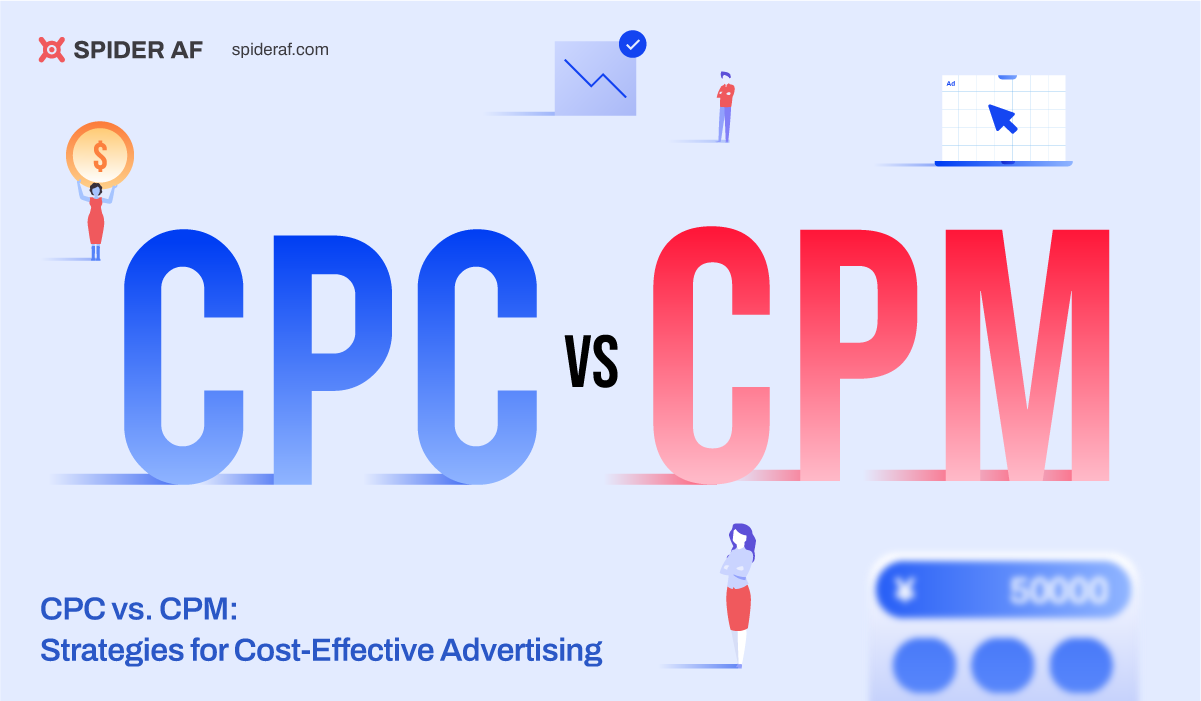What is CPM (Cost Per Mille)?
CPM stands for Cost Per Mille, with “mille” meaning thousand in Latin. In this model, advertisers pay for 1,000 impressions of their ad, meaning they are charged based on how often their ad is displayed, regardless of whether users interact with it or not. This makes CPM ideal for brand awareness campaigns where the goal is to reach a broad audience rather than drive specific actions like clicks or conversions.How Does CPM Work?
In a CPM model, you pay for the impression count—this means you are billed every time your ad is shown to a thousand users. The primary goal of CPM advertising is to maximize reach and visibility, making it a popular choice for businesses looking to establish their brand in the market. While CPM can help spread your message to a large number of people, it’s not designed for performance metrics like clicks or purchases. It’s about getting eyes on your product or service, even if users don’t interact with your ad.
What is CPC (Cost Per Click)?
On the other hand, CPC stands for Cost Per Click, which is a model where advertisers only pay when a user actually clicks on their ad. Unlike CPM, which focuses on impressions, CPC is about performance, specifically driving clicks to your website, landing page, or app.How Does CPC Work?
In a CPC model, you are charged only when someone clicks on your ad. The CPC rate can vary depending on factors like the advertising platform, keyword competition, and how well the ad is targeted. This makes CPC a more performance-driven model, where advertisers are focused on getting users to take a specific action—like visiting a website, signing up for a newsletter, or making a purchase. CPC campaigns are ideal when the goal is to generate traffic and conversions rather than just brand visibility. Because you only pay when a user clicks, you can more directly track the return on investment (ROI) of your campaigns.Key Differences Between CPM and CPC
Now that we’ve covered the basics of CPM and CPC, let’s compare the two to understand which one is better suited for specific campaign objectives.1. Payment Structure:
- CPM: You pay for 1,000 impressions, regardless of whether users interact with the ad.
- CPC: You pay only when someone clicks on your ad.
2. Campaign Goal:
- CPM: Best suited for brand awareness and reaching a broad audience.
- CPC: Ideal for performance-based campaigns where the goal is to drive traffic, leads, or sales.
3. Cost Control:
- CPM: The cost is based on the number of impressions, so it’s easier to predict the cost for a given number of views.
- CPC: With CPC, the cost is directly tied to the clicks your ad receives, meaning it’s more performance-driven.
4. Metrics:
- CPM: You can track impressions, which shows how many times your ad has been displayed.
- CPC: You can track click-through rates (CTR) and measure how many users interacted with the ad.
5. Effectiveness:
- CPM: More effective for building brand awareness and visibility.
- CPC: More effective for driving traffic and conversions.
When Should You Use CPM?
CPM is a great choice when your main objective is to raise brand awareness and increase exposure. If you’re looking to get your ad in front of as many people as possible, CPM is an ideal choice because it maximizes the number of impressions.Advantages of Using CPM:
- Ideal for broad-reaching campaigns: If you’re aiming to expose your brand to a large audience, CPM allows you to get the most visibility.
- Predictable Costs: With CPM, you know the cost for every 1,000 impressions, which makes it easier to set and stick to a budget.
- Works well for visual ads: Banner ads and other display ads can be particularly effective in CPM campaigns as their goal is exposure rather than user interaction.

When Should You Use CPC?
CPC is the better option when your focus is on performance, such as driving traffic to a landing page or increasing conversions. If you want users to engage with your ad—whether by clicking, purchasing, or subscribing—then CPC is the right choice for you.Advantages of Using CPC:
- Performance-Based: CPC ensures you’re only paying for actual user engagement (clicks), which can be more cost-effective if your goal is to drive website traffic or conversions.
- Better Control Over Costs: You control how much you spend by setting your bid per click, which helps manage your ad spend based on how many clicks you want to achieve.
- Effective for targeted campaigns: If your audience is well-defined, CPC allows for a more direct path to conversion.
Which is More Cost-Effective?
Choosing between CPM and CPC depends largely on your advertising goals.When CPM is More Cost-Effective:
- If your objective is to build brand awareness and reach as many people as possible.
- When you want wide exposure with a fixed cost, making it easier to manage your budget.
When CPC is More Cost-Effective:
- If your focus is on driving targeted traffic or encouraging specific actions (such as clicks, conversions, or sales).
- If you need to track ROI more directly and efficiently, since you only pay for actual clicks.
In the next section, we’ll take a closer look at practical examples of successful campaigns using both CPM and CPC models, so you can see how these strategies play out in real-world scenarios. Stay tuned for more insights!
Examples of Successful CPM and CPC Campaigns
Understanding the practical applications of CPM and CPC will help you make an informed decision when choosing which model to use for your campaigns. Let’s explore a few examples of how these models are utilized by businesses in the real world.Successful CPM Campaign:
A great example of a CPM campaign can be seen in the automobile industry, where car manufacturers often run ads to build brand awareness. For instance, a company like Tesla may choose to run CPM campaigns to display ads for their electric vehicles to a broad audience. These ads aim to expose the brand to potential customers, increasing visibility without necessarily requiring users to interact immediately. In this case, the key performance indicator (KPI) would be the total number of impressions or how many people saw the ad. Why CPM Works Here:- The goal isn’t to get immediate clicks or conversions, but to familiarize people with the brand.
- CPM helps reach a wide audience, especially for high-cost items like cars, where building trust and recognition is important over time.
Successful CPC Campaign:
An excellent example of a CPC campaign is Amazon’s Sponsored Product Ads. These ads are designed to drive direct conversions by targeting people actively searching for products similar to those Amazon sells. Advertisers using Amazon PPC pay for every click on their ad, meaning that they’re only paying for users who show a direct interest by clicking. Why CPC Works Here:- The goal is to drive specific actions, such as a purchase, sign-up, or download.
- The cost is directly tied to how many users engage with the ad by clicking, so Amazon can track the ROI of the campaign more precisely.
CPM vs. CPC: Which One is Right for You?
When deciding between CPM and CPC, it all comes down to your campaign objectives. Let’s break it down further:Choose CPM If:
- You want brand exposure and are looking to target a wide audience.
- Your budget is fixed, and you want to ensure you reach a specific number of people within your set parameters.
- You’re running display ads, banner ads, or video ads that prioritize visibility over direct action.
Choose CPC If:
- Your goal is to drive direct traffic to your website or landing page.
- You need a performance-based model where you’re only paying for actual user interaction (clicks).
- You’re tracking specific conversions, such as sales, sign-ups, or other actions.
Key Takeaways:
- CPM focuses on impressions and is best for increasing brand visibility, whereas CPC focuses on clicks and is ideal for driving specific actions.
- Both models have distinct advantages, and choosing the right one depends on your goals—whether it’s building awareness or increasing conversions.
- Experimenting with both models on different campaigns can give you valuable insights into what works best for your specific target audience.
